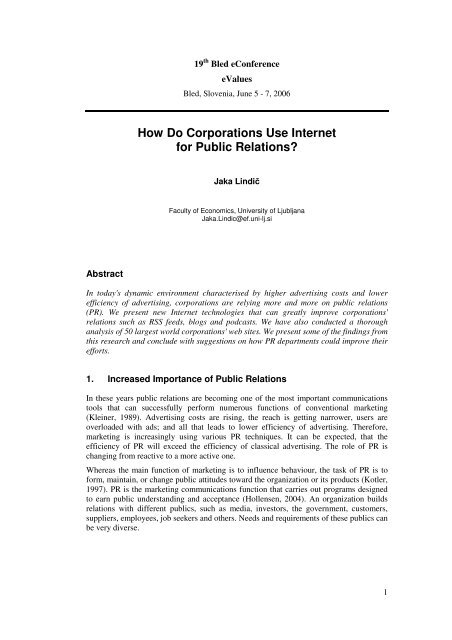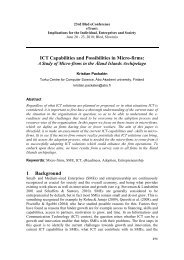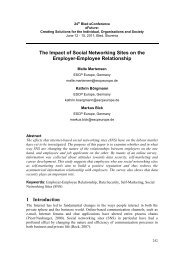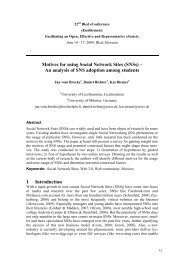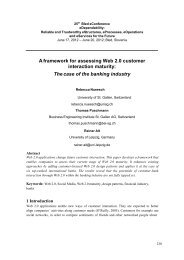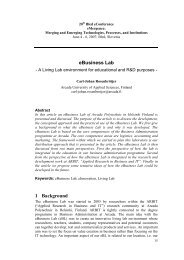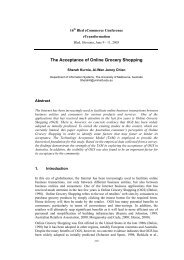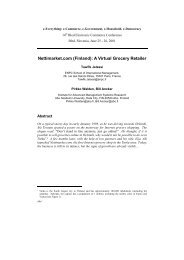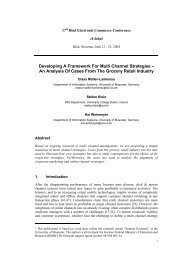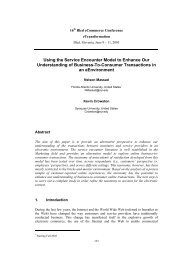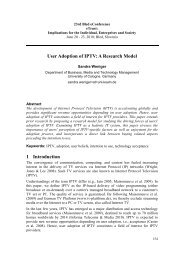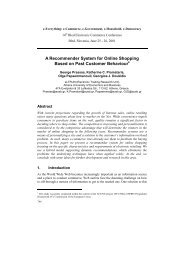How Do Corporations Use Internet for Public Relations?
How Do Corporations Use Internet for Public Relations?
How Do Corporations Use Internet for Public Relations?
You also want an ePaper? Increase the reach of your titles
YUMPU automatically turns print PDFs into web optimized ePapers that Google loves.
Abstract<br />
19 th Bled eConference<br />
eValues<br />
Bled, Slovenia, June 5 - 7, 2006<br />
<strong>How</strong> <strong>Do</strong> <strong>Corporations</strong> <strong>Use</strong> <strong>Internet</strong><br />
<strong>for</strong> <strong>Public</strong> <strong>Relations</strong>?<br />
Jaka Lindič<br />
Faculty of Economics, University of Ljubljana<br />
Jaka.Lindic@ef.uni-lj.si<br />
In today's dynamic environment characterised by higher advertising costs and lower<br />
efficiency of advertising, corporations are relying more and more on public relations<br />
(PR). We present new <strong>Internet</strong> technologies that can greatly improve corporations'<br />
relations such as RSS feeds, blogs and podcasts. We have also conducted a thorough<br />
analysis of 50 largest world corporations' web sites. We present some of the findings from<br />
this research and conclude with suggestions on how PR departments could improve their<br />
ef<strong>for</strong>ts.<br />
1. Increased Importance of <strong>Public</strong> <strong>Relations</strong><br />
In these years public relations are becoming one of the most important communications<br />
tools that can successfully per<strong>for</strong>m numerous functions of conventional marketing<br />
(Kleiner, 1989). Advertising costs are rising, the reach is getting narrower, users are<br />
overloaded with ads; and all that leads to lower efficiency of advertising. There<strong>for</strong>e,<br />
marketing is increasingly using various PR techniques. It can be expected, that the<br />
efficiency of PR will exceed the efficiency of classical advertising. The role of PR is<br />
changing from reactive to a more active one.<br />
Whereas the main function of marketing is to influence behaviour, the task of PR is to<br />
<strong>for</strong>m, maintain, or change public attitudes toward the organization or its products (Kotler,<br />
1997). PR is the marketing communications function that carries out programs designed<br />
to earn public understanding and acceptance (Hollensen, 2004). An organization builds<br />
relations with different publics, such as media, investors, the government, customers,<br />
suppliers, employees, job seekers and others. Needs and requirements of these publics can<br />
be very diverse.<br />
1
2<br />
Jaka Lindič<br />
2. <strong>Public</strong> <strong>Relations</strong> and the <strong>Internet</strong><br />
PR is one of the most important tasks marketing has to per<strong>for</strong>m. <strong>Relations</strong> with media and<br />
journalists can have a strong influence on the image of an organization among other<br />
publics. When using technology in PR with media, the goal should be focused on getting<br />
the job done quickly and as easy as possible. This is one of the rare situations where<br />
company can simultaneously per<strong>for</strong>m better and at a lower cost. With the use of <strong>Internet</strong><br />
related technologies, the costs of reaching journalists are much lower than classical ways<br />
of communication.<br />
But even other publics (customers, employees, suppliers) are not so much dependent on<br />
the in<strong>for</strong>mation from journals and editors as they used to be. They can use different<br />
independent communities and mediators, such as epinions.com.<br />
The <strong>Internet</strong> offers several advantages when compared to the other media such as speed<br />
of communication, almost immediate product delivery, interactivity, customization and<br />
personalization; it can improve productivity, efficiency and issues management. The<br />
<strong>Internet</strong> also provides an ideal <strong>for</strong>um <strong>for</strong> group communication and interaction (Ashcroft,<br />
2001, Macintosh, 2000, Sallot, 2004).<br />
It has dramatically changed the way public relations practitioners distribute in<strong>for</strong>mation,<br />
interact with key publics, deal with crises, and manage issues (Hallahan, 2004).<br />
There are two major groups of tools organizations can use to improve PR ef<strong>for</strong>ts: special<br />
media web sites that are dedicated to the press and automatic dissemination of<br />
personalized content (RSS feed, podcasts).<br />
2.1 Special Media Web Sites<br />
Organizations can <strong>for</strong>m special media related web sites, such as News @ Cisco:<br />
newsroom.cisco.com; Verizon News Center: newscenter.verizon.com; or DaimlerChrysler<br />
media services: media.daimlerchrysler.com. These web sites can offer tools and<br />
in<strong>for</strong>mation such as:<br />
• different facts, in<strong>for</strong>mation, news and archives<br />
(Beside classic content such as in<strong>for</strong>mation about products and services, company<br />
structure, company governance, markets, financial results, history, and awards,<br />
also contacts, clippings, customers' stories, biographies of key personnel, their<br />
views and perspectives of the company.),<br />
• calendar of activities<br />
(Appearances of key personnel, events organized by the company with contacts<br />
of key contacts),<br />
• multimedia content<br />
(Speeches, pictures and logos in different resolutions.) – Many media companies<br />
need graphical material <strong>for</strong> their editions (picture of products, packaging,<br />
customers while they are using the product or service, employees at their work,<br />
diagrams of key corporative processes, etc.),<br />
• links to external sources including those with negative comments and remarks<br />
(Journalist will probably find those pages anyway. This way company gets the<br />
chance to respond in advance, even be<strong>for</strong>e any bad press can get out.),<br />
• the possibility to order news alerts, online newspapers, RSS feeds, podcasts, to<br />
arrange interviews, etc.<br />
One of the greatest advantages of the <strong>Internet</strong> is its ability to react quickly. That is<br />
especially important in crises. Companies can prepare crisis-ready web sites that enable
<strong>How</strong> <strong>Do</strong> <strong>Corporations</strong> <strong>Use</strong> <strong>Internet</strong> <strong>for</strong> <strong>Public</strong> <strong>Relations</strong>?<br />
them a quick response. These sites can be 80% prebuild, URL's can be registered, and<br />
content approval procedures can be executed (Guineven, 2004, p. 6).<br />
2.2 Web Blogs<br />
A web blog, a weblog or, in short, a blog is a publication which uses web technology. Its<br />
content is usually published periodically. Blogs enable readers to comment, providing a<br />
collaborative space. A newer "version" of blogs is represented by corporative blogs,<br />
where content is written by an individual or a group of employees. The purpose of a<br />
corporate blog is to spark in<strong>for</strong>mal conversation about the organization and its products<br />
and/or services among its publics (Albrycht, 2004, p. 14). The corporative blogs are<br />
already used by a range of companies from various industries. In a research per<strong>for</strong>med by<br />
PRWeek among the U.S. CEOs, it was discovered that 7% of the U.S. CEOs have their<br />
own blog. They list key advantages of blogs as quick communication of new ideas,<br />
greater in<strong>for</strong>mality, quick internal response and a place <strong>for</strong> innovation and good<br />
leadership (Hood, 2005).<br />
Most journalists use the <strong>Internet</strong> to explore the field, to search <strong>for</strong> news releases, to seek<br />
new sources or experts to interview or quote. More than half of journalists use blogs as a<br />
source of in<strong>for</strong>mation (Euro RSCG Magnet, 2005). They trust more the in<strong>for</strong>mation<br />
coming from individual blogers who are the companies' employees than they trust<br />
in<strong>for</strong>mation prepared by companies' PR department. One of the research showed, that at<br />
least half of respondents trust corporate blogs, and 77 % trust employees' blogs<br />
(Technoraty, 2005). Although they have confidence in blogs, the confidence is higher<br />
with individual employees. There<strong>for</strong>e, the internal communication is of utter importance<br />
<strong>for</strong> the companies. And also in internal communication, blogs can be a powerful tool. One<br />
of the first companies that used blogs <strong>for</strong> internal communications was Disney<br />
Corporation.<br />
Motives <strong>for</strong> an internal use of blogs are several: the reduction of imperfections of<br />
traditional in<strong>for</strong>mation transfer, improved dissemination, archives, nurtured<br />
communications between teams and departments and easier search. <strong>Corporations</strong> can<br />
resort to blogs in order to directly communicate with different publics. For example,<br />
Cisco uses its Cisco High Tech Policy Blog (www.cisco.com/gov/blog/) to communicate<br />
with governmental institutions. Mattel's Barbie wrote her first blog back in November<br />
2002 (www.myscene.com/friends/barbie). One of more recent examples of blogs with the<br />
similar goals is Nokia N90 (n90.bloggercomm.com/). It offers in<strong>for</strong>mation about the<br />
product, links to comments, and answers to different questions. Even more interestingly,<br />
it provides sources <strong>for</strong> generating ideas <strong>for</strong> new products. Nokia is already planning<br />
similar actions <strong>for</strong> its N71 and N91 models.<br />
2.3 RSS Feeds<br />
It is estimated that the <strong>Internet</strong> doubles in size every 11 months and the World Wide Web<br />
doubles every 53 days (Ashcroft, 2001). All that leads to in<strong>for</strong>mation overload and<br />
saturation (Ryan, 2003). PR practitioners today are faced with a situation where merely a<br />
continuously update of the content is not enough. What is needed is a set of tools <strong>for</strong><br />
automatic dissemination of personalized content.<br />
RSS is a family of XML dialects, which is used <strong>for</strong> syndication of the web content. RSS<br />
2.0 stands <strong>for</strong> Really Simple Syndication. RSS feeds usually include a short description of<br />
the content with a link to a full version. Journalists and others can reduce the volume of<br />
in<strong>for</strong>mation. For corporations, they represent an alternative communication channel that<br />
can be <strong>for</strong> direct communication with the target publics.<br />
3
4<br />
Jaka Lindič<br />
What differentiates RSS from e-mail is basically the feature that allows users to control<br />
incoming in<strong>for</strong>mation streams. They can choose exactly what they would like to receive.<br />
If they like what they are receiving they will continue to be a subscriber, otherwise they<br />
will cancel their subscription. The second difference lies in the fact that the users don't<br />
have to read RSS, they can just skim through the titles. They don't have to worry about<br />
deleting an important email by mistake. <strong>Use</strong>rs are essentially in control.<br />
<strong>Public</strong> relations industry also defined a customized XML - XPRL (eXtensible <strong>Public</strong><br />
<strong>Relations</strong> Language). XPRL aims to assist practitioners to transfer data or in<strong>for</strong>mation<br />
electronically. Its purpose is to automate in<strong>for</strong>mation exchange as much as possible, the<br />
result being quicker and higher quality communication, with fewer errors (Gregory,<br />
2004).<br />
2.4 Podcasts<br />
Podcasting is similar to RSS and allows subscribers to subscribe to the feeds of a<br />
syndicated content. The main difference is that instead of reading the feeds on computer<br />
screen, users listen to and view the new content on their personal computer or mobile<br />
devices such as iPod. A podcast is a web feed of audio or video files placed on the<br />
<strong>Internet</strong> <strong>for</strong> anyone to subscribe to. As Wikipedia describes it podcasting's essence is<br />
about creating content (audio or video) <strong>for</strong> an audience that wants to listen when they<br />
want, where they want, and the way they want.<br />
The key distinction between podcasts and audio video files is not in the content but rather<br />
in the delivery method. Podcasts can be used <strong>for</strong> internal communication: the CEO can<br />
use it <strong>for</strong> weekly communication of major business decisions, the marketing and R&D<br />
departments can communicate key features of a new product, etc.<br />
3. Research<br />
As there are many technological possibilities to improve PR ef<strong>for</strong>ts, we decided to<br />
analyse how the largest world's corporations are embracing this new possibilities. We<br />
chose the top 50 corporations from Fortune Global 500 list. The list is presented in the<br />
appendix. It includes companies from different countries and industries.<br />
We analysed how their PR department used different <strong>Internet</strong> technologies (web sites, email<br />
newsletters, RSS, podcasts and blogs) to communicate with different publics (media,<br />
investors, customers, suppliers, government & community, job seekers). If a technology<br />
or a tool was not present on their web sites, we assumed they do not use it <strong>for</strong> their PR<br />
ef<strong>for</strong>ts. Consequently, there is a possibility that we underestimate some PR ef<strong>for</strong>ts from<br />
these corporations. Let's illustrate this point with the following example. Toyota offers<br />
podcasts <strong>for</strong> their new Lexus model. As this is only featured on its microsite<br />
LexusFusion.com and it is not mentioned anywhere on the corporate web site, we did not<br />
mark it as a podcast ef<strong>for</strong>t from their PR department. The analysis was carried out in<br />
January 2006.<br />
Although internal communication can be greatly supported by modern technologies, it<br />
was not included in the research, as it would require an input from the corporations and<br />
the cost structure of the research could not support the additional costs.
<strong>How</strong> <strong>Do</strong> <strong>Corporations</strong> <strong>Use</strong> <strong>Internet</strong> <strong>for</strong> <strong>Public</strong> <strong>Relations</strong>?<br />
4. Findings and Conclusions<br />
All of the 50 analysed corporations had a web site. With the exception of one company all<br />
of them used the <strong>Internet</strong> to support PR. Most of them (38) used more than one<br />
technology.<br />
Number of companies<br />
30<br />
25<br />
20<br />
15<br />
10<br />
5<br />
0<br />
1<br />
Diversity of technologies used<br />
11<br />
26<br />
0 1 2 3 4 5<br />
Number of technologies used<br />
Figure 1: Diversity of technologies used <strong>for</strong> PR support<br />
Companies using more than two technologies usually use different technologies to<br />
support PR with different groups. But there seem to be some rules. Typically job seekers<br />
are supported with a web site describing corporation's policies towards its employees and<br />
the listing of job opportunities. Most of these web sites also offer a web <strong>for</strong>m where a<br />
candidate can post his or her resume and apply <strong>for</strong> a job. Several corporations also use email<br />
alerts to keep users in<strong>for</strong>med of new job openings.<br />
Table 1: Technology used to support individual publics<br />
Suppliers 20 1<br />
5<br />
Web site E-Mail RSS feeds Podcasts Blogs<br />
Government & community 45 7 1 1<br />
Career 45 19<br />
Investor 47 27 2 2<br />
Customers 47 7 2 1 3<br />
Media 49 28 11 5 5<br />
The most supported group (both in the sense of diversity and frequency of technologies<br />
used) is media. It is followed by investors, job seekers and customers.<br />
3<br />
4<br />
5
6<br />
Jaka Lindič<br />
In media relations e-mails are used to notify journalists about the corporate news and alert<br />
them about the <strong>for</strong>thcoming events. Some corporations even offer the option of setting the<br />
time lag between an alert and the event. Expectedly, the government, the community and<br />
suppliers are the least supported groups. Nevertheless, some corporations, e.g. Siemens<br />
and Deutsche Telekom, use technology to <strong>for</strong>m and strengthen relationships with<br />
suppliers.<br />
As it is shown in Figure 1 the corporations under study primarily use the web site and the<br />
e-mail as communication tools. But RSS feeds are gaining importance. 11 of analysed<br />
corporations used RSS feeds <strong>for</strong> media and news. IBM, <strong>for</strong> example, offers 300 different<br />
RSS feeds to choose from, ranging from special offers, press room, support to investor<br />
relations and many more. GM's Fastlane Blog (fastlane.gmblogs.com/) offers blogs and<br />
podcasts from categories such as auto shows, business and design. It also offers users<br />
RSS subscriptions to the new content.<br />
A minority of workers agrees that e-mail and other technologies are hindering their<br />
productivity (Barkow, 2004, p. 12). Nevertheless spam, worms and other anomalies teach<br />
us that technology can quickly surpass our ability to manage it.<br />
Blog<br />
Podcast<br />
50 Web<br />
40<br />
30<br />
20<br />
10<br />
0<br />
RSS<br />
Figure 2: <strong>Use</strong> of different <strong>Internet</strong> tools <strong>for</strong> PR ef<strong>for</strong>ts<br />
Mail<br />
Suppliers<br />
Government &<br />
community<br />
Career<br />
Investor<br />
Customers<br />
Media<br />
Although the strategic use of the internet has clearly empowered and enhanced the role of<br />
public relations practitioners (Sallot, 2004, str. 276) and regardless of the fact they have<br />
abandoned the debate about whether the <strong>Internet</strong> is useful in public relations (Ryan, 2003,<br />
str. 345), the exploitation of opportunities the <strong>Internet</strong> offers is shockingly low. All of the<br />
examined corporations have a web site, and almost all of them use it in some way to<br />
support relations with different groups. Our findings, however, show that there are a lot of<br />
unexplored and unexploited opportunities that could improve their PR ef<strong>for</strong>ts<br />
significantly. Most opportunities lie in the area of generating more content and adding it<br />
more frequently. The second opportunity that seems to be even more important <strong>for</strong><br />
several of analysed corporations is hidden in the methods <strong>for</strong> automated distribution of<br />
customized web content, such as RSS feeds, podcasts and still e-mail alerts. Research
<strong>How</strong> <strong>Do</strong> <strong>Corporations</strong> <strong>Use</strong> <strong>Internet</strong> <strong>for</strong> <strong>Public</strong> <strong>Relations</strong>?<br />
suggest also suggests that higher-ranking companies often offer more online then the<br />
lower-ranking ones (Callison, 2003, p. 29). That shows the industry in even worse light.<br />
A part of the reason can be found with the largest PR agencies that are often responsible<br />
<strong>for</strong> the success of PR ef<strong>for</strong>ts made by the world's largest companies. One research<br />
showed that only <strong>for</strong> of the largest 50 PR agencies offered sign up <strong>for</strong> mailing lists and<br />
discussion groups (Anderson, 2005). The analysis also showed a very poor usage of the<br />
wide spectrum of opportunities.<br />
Strategic use of the internet has clearly empowered and enhanced the role of public<br />
relations practitioners. They can use it as a “standard operating procedure”; as the<br />
“ultimate” research tool; as a way to “laser-target” publics and improve media relations;<br />
to better evaluate programs and campaigns, identify and manage issues and crises, and<br />
improve relationships with management and clients; to equalize gender, age, and tenure<br />
differences; and to advance their careers (Sallot, 2004). Some of the more prominent<br />
authors agree that the proper use of technology can lead to extraordinary results <strong>for</strong> global<br />
media relations (O'Keefe in Sparks, FitzGerald, 2003). There<strong>for</strong>e further research is<br />
needed in the area of how efficient are companies in using these technologies and do<br />
small and medium size companies use them.<br />
References<br />
Albrycht Elizabeth, (2004): "Turning blogs into useful communications tools", Tactics, p.<br />
14-15.<br />
Anderson William B, (2005): "PR firms on the <strong>Internet</strong>: <strong>How</strong> well are they using the Web<br />
to promote their services?", Tactics, p. 27.<br />
Ashcroft Linda and Hoey Clive, (2001): "PR, marketing and the <strong>Internet</strong>: implications <strong>for</strong><br />
in<strong>for</strong>mation professionals", Library Management, Vol. 22, pp. 68-74.<br />
Barkow, Tim (2004): "In<strong>for</strong>mation overload", Tactics, p. 12.<br />
Callison, Coy, (2003): "Media relations and the <strong>Internet</strong>: how Fortune 500 company web<br />
sites assist journalists in news gathering", <strong>Public</strong> <strong>Relations</strong> Review, Vol. 29, p.<br />
29-41.<br />
Carton, S., (2005): "What <strong>Do</strong>es RSS Mean <strong>for</strong> Advertisers?". Incisive Interactive<br />
Marketing. London.<br />
Cooley Tracy (1999): "Interactive Communication – <strong>Public</strong> Realtions on the Web",<br />
summer 1999, <strong>Public</strong> <strong>Relations</strong> Quarterly, p. 41-42.<br />
Gordon-MacIntosh, J. (2000), "Entering an uncertain world'', Profile, Vol. 6, May, p. 22.<br />
Gregory, Anne (2004), "Scope and structure of public relations: a technology driven<br />
view", <strong>Public</strong> <strong>Relations</strong> Review, Vol 30, p. 245-254.<br />
Guineven, John (2004), "Crisis-ready Web sites", Tactics, 2004, p. 6.<br />
Hallahan, K., (2004): "Protecting an organization’s digital public relations assets", <strong>Public</strong><br />
<strong>Relations</strong> Review, Vol. 30, p. 255-268.<br />
Hollensten, S., (2004): "Global Marketing, " Prentice Hall, Harlow.<br />
Kotler P., (1997), "Standing Room Only," Harvard Business School Press, Boston.<br />
Kleiner A., (1989): "The <strong>Public</strong> <strong>Relations</strong> Coup," Adweek's Marketing Week, January 16.<br />
Hood J., (2005): " Blogs are all the rage, but few CEOs are writing their own or plan to<br />
any time soon", PRWeek, New York, 11/7/2005.<br />
7
8<br />
Jaka Lindič<br />
Marken, G.A. (2005): "To Blog or Not to Blog. That is the Question?", <strong>Public</strong> <strong>Relations</strong><br />
Quarterly, Fall 2005, p 31-33.<br />
RSCG Magnet, (2005): "Eleventh Annual Survey of the Media", RSCG Magnet and<br />
Columbia University Graduate School of Journalism", New York.<br />
Ryan Michael, Monitor technologies carefully: poor applications can drive clients and<br />
customers to competitors, <strong>Public</strong> <strong>Relations</strong> Quarterly 45 (2000), p. 20.<br />
Ryan Michael, <strong>Public</strong> relations and the web: organizational problems, gender, and<br />
institution type, <strong>Public</strong> <strong>Relations</strong> Review 29 (2003), p. 345.<br />
Sparks FitzGerald, Suzanne: "Prediction <strong>for</strong> the New Millenium – Have They Come<br />
True?", <strong>Public</strong> <strong>Relations</strong> Quarterly, Winter 2003, p. 28-30.<br />
Technorati, (2005): "Blogs & Business", eMarketer, New York. 4.11.2005.<br />
Van der Merwe Ryan, Pitt L. F., Abratt R.: "Stakeholder strength: PR Survival Strategies<br />
in the <strong>Internet</strong> Age", <strong>Public</strong> <strong>Relations</strong> Quarterly, Spring 2005, p. 39-48.


